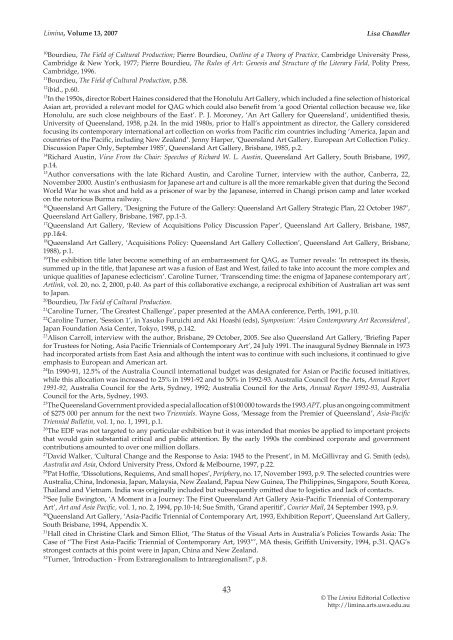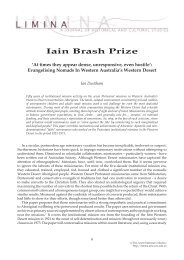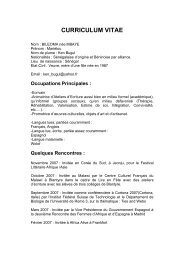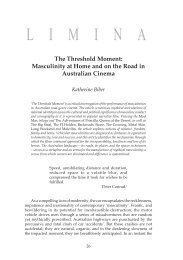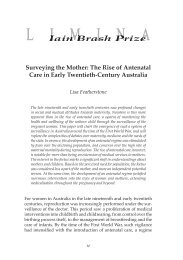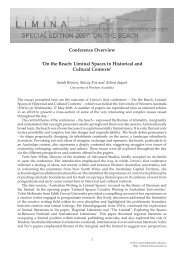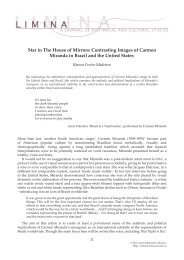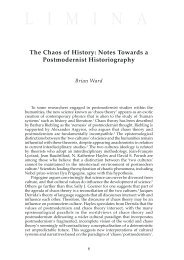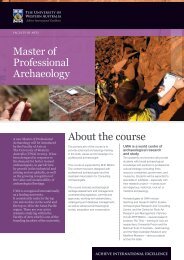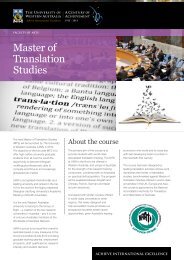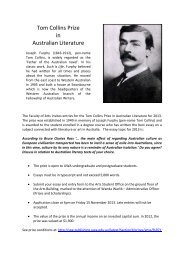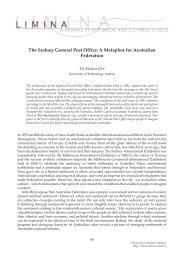'The Asia-Pacific Effect': Geo-Cultural Grouping at the ... - Past volumes
'The Asia-Pacific Effect': Geo-Cultural Grouping at the ... - Past volumes
'The Asia-Pacific Effect': Geo-Cultural Grouping at the ... - Past volumes
Create successful ePaper yourself
Turn your PDF publications into a flip-book with our unique Google optimized e-Paper software.
Limina, Volume 13, 2007<br />
Lisa Chandler<br />
10 Bourdieu, The Field of <strong>Cultural</strong> Production; Pierre Bourdieu, Outline of a Theory of Practice, Cambridge University Press,<br />
Cambridge & New York, 1977; Pierre Bourdieu, The Rules of Art: Genesis and Structure of <strong>the</strong> Literary Field, Polity Press,<br />
Cambridge, 1996.<br />
11 Bourdieu, The Field of <strong>Cultural</strong> Production, p.58.<br />
12 ibid., p.60.<br />
13 In <strong>the</strong> 1950s, director Robert Haines considered th<strong>at</strong> <strong>the</strong> Honolulu Art Gallery, which included a fine selection of historical<br />
<strong>Asia</strong>n art, provided a relevant model for QAG which could also benefit from ‘a good Oriental collection because we, like<br />
Honolulu, are such close neighbours of <strong>the</strong> East’. P. J. Moroney, ‘An Art Gallery for Queensland’, unidentified <strong>the</strong>sis,<br />
University of Queensland, 1958, p.24. In <strong>the</strong> mid 1980s, prior to Hall’s appointment as director, <strong>the</strong> Gallery considered<br />
focusing its contemporary intern<strong>at</strong>ional art collection on works from <strong>Pacific</strong> rim countries including ‘America, Japan and<br />
countries of <strong>the</strong> <strong>Pacific</strong>, including New Zealand’. Jenny Harper, ‘Queensland Art Gallery. European Art Collection Policy.<br />
Discussion Paper Only, September 1985’, Queensland Art Gallery, Brisbane, 1985, p.2.<br />
14 Richard Austin, View From <strong>the</strong> Chair: Speeches of Richard W. L. Austin, Queensland Art Gallery, South Brisbane, 1997,<br />
p.14.<br />
15 Author convers<strong>at</strong>ions with <strong>the</strong> l<strong>at</strong>e Richard Austin, and Caroline Turner, interview with <strong>the</strong> author, Canberra, 22,<br />
November 2000. Austin’s enthusiasm for Japanese art and culture is all <strong>the</strong> more remarkable given th<strong>at</strong> during <strong>the</strong> Second<br />
World War he was shot and held as a prisoner of war by <strong>the</strong> Japanese, interred in Changi prison camp and l<strong>at</strong>er worked<br />
on <strong>the</strong> notorious Burma railway.<br />
16 Queensland Art Gallery, ‘Designing <strong>the</strong> Future of <strong>the</strong> Gallery: Queensland Art Gallery Str<strong>at</strong>egic Plan, 22 October 1987’,<br />
Queensland Art Gallery, Brisbane, 1987, pp.1-3.<br />
17 Queensland Art Gallery, ‘Review of Acquisitions Policy Discussion Paper’, Queensland Art Gallery, Brisbane, 1987,<br />
pp.1&4.<br />
18 Queensland Art Gallery, ‘Acquisitions Policy: Queensland Art Gallery Collection’, Queensland Art Gallery, Brisbane,<br />
1988), p.1.<br />
19 The exhibition title l<strong>at</strong>er become something of an embarrassment for QAG, as Turner reveals: ‘In retrospect its <strong>the</strong>sis,<br />
summed up in <strong>the</strong> title, th<strong>at</strong> Japanese art was a fusion of East and West, failed to take into account <strong>the</strong> more complex and<br />
unique qualities of Japanese eclecticism’. Caroline Turner, ‘Transcending time: <strong>the</strong> enigma of Japanese contemporary art’,<br />
Artlink, vol. 20, no. 2, 2000, p.40. As part of this collabor<strong>at</strong>ive exchange, a reciprocal exhibition of Australian art was sent<br />
to Japan.<br />
20 Bourdieu, The Field of <strong>Cultural</strong> Production.<br />
21 Caroline Turner, ‘The Gre<strong>at</strong>est Challenge’, paper presented <strong>at</strong> <strong>the</strong> AMAA conference, Perth, 1991, p.10.<br />
22 Caroline Turner, ‘Session 1’, in Yasuko Furuichi and Aki Hoashi (eds), Symposium: ‘<strong>Asia</strong>n Contemporary Art Reconsidered’,<br />
Japan Found<strong>at</strong>ion <strong>Asia</strong> Center, Tokyo, 1998, p.142.<br />
23 Alison Carroll, interview with <strong>the</strong> author, Brisbane, 29 October, 2005. See also Queensland Art Gallery, ‘Briefing Paper<br />
for Trustees for Noting, <strong>Asia</strong> <strong>Pacific</strong> Triennials of Contemporary Art’, 24 July 1991. The inaugural Sydney Biennale in 1973<br />
had incorpor<strong>at</strong>ed artists from East <strong>Asia</strong> and although <strong>the</strong> intent was to continue with such inclusions, it continued to give<br />
emphasis to European and American art.<br />
24 In 1990-91, 12.5% of <strong>the</strong> Australia Council intern<strong>at</strong>ional budget was design<strong>at</strong>ed for <strong>Asia</strong>n or <strong>Pacific</strong> focused initi<strong>at</strong>ives,<br />
while this alloc<strong>at</strong>ion was increased to 25% in 1991-92 and to 50% in 1992-93. Australia Council for <strong>the</strong> Arts, Annual Report<br />
1991-92, Australia Council for <strong>the</strong> Arts, Sydney, 1992; Australia Council for <strong>the</strong> Arts, Annual Report 1992-93, Australia<br />
Council for <strong>the</strong> Arts, Sydney, 1993.<br />
25 The Queensland Government provided a special alloc<strong>at</strong>ion of $100 000 towards <strong>the</strong> 1993 APT, plus an ongoing commitment<br />
of $275 000 per annum for <strong>the</strong> next two Triennials. Wayne Goss, ‘Message from <strong>the</strong> Premier of Queensland’, <strong>Asia</strong>-<strong>Pacific</strong><br />
Triennial Bulletin, vol. 1, no. 1, 1991, p.1.<br />
26 The EDF was not targeted to any particular exhibition but it was intended th<strong>at</strong> monies be applied to important projects<br />
th<strong>at</strong> would gain substantial critical and public <strong>at</strong>tention. By <strong>the</strong> early 1990s <strong>the</strong> combined corpor<strong>at</strong>e and government<br />
contributions amounted to over one million dollars.<br />
27 David Walker, ‘<strong>Cultural</strong> Change and <strong>the</strong> Response to <strong>Asia</strong>: 1945 to <strong>the</strong> Present’, in M. McGillivray and G. Smith (eds),<br />
Australia and <strong>Asia</strong>, Oxford University Press, Oxford & Melbourne, 1997, p.22.<br />
28 P<strong>at</strong> Hoffie, ‘Dissolutions, Requiems, And small hopes’, Periphery, no. 17, November 1993, p.9. The selected countries were<br />
Australia, China, Indonesia, Japan, Malaysia, New Zealand, Papua New Guinea, The Philippines, Singapore, South Korea,<br />
Thailand and Vietnam. India was originally included but subsequently omitted due to logistics and lack of contacts.<br />
29 See Julie Ewington, ‘A Moment in a Journey: The First Queensland Art Gallery <strong>Asia</strong>-<strong>Pacific</strong> Triennial of Contemporary<br />
Art’, Art and <strong>Asia</strong> <strong>Pacific</strong>, vol. 1, no. 2, 1994, pp.10-14; Sue Smith, ‘Grand aperitif’, Courier Mail, 24 September 1993, p.9.<br />
30 Queensland Art Gallery, ‘<strong>Asia</strong>-<strong>Pacific</strong> Triennial of Contemporary Art, 1993, Exhibition Report’, Queensland Art Gallery,<br />
South Brisbane, 1994, Appendix X.<br />
31 Hall cited in Christine Clark and Simon Elliot, ‘The St<strong>at</strong>us of <strong>the</strong> Visual Arts in Australia’s Policies Towards <strong>Asia</strong>: The<br />
Case of “The First <strong>Asia</strong>-<strong>Pacific</strong> Triennial of Contemporary Art, 1993”’, MA <strong>the</strong>sis, Griffith University, 1994, p.31. QAG’s<br />
strongest contacts <strong>at</strong> this point were in Japan, China and New Zealand.<br />
32 Turner, ‘Introduction - From Extraregionalism to Intraregionalism?’, p.8.<br />
43<br />
© The Limina Editorial Collective<br />
http://limina.arts.uwa.edu.au


